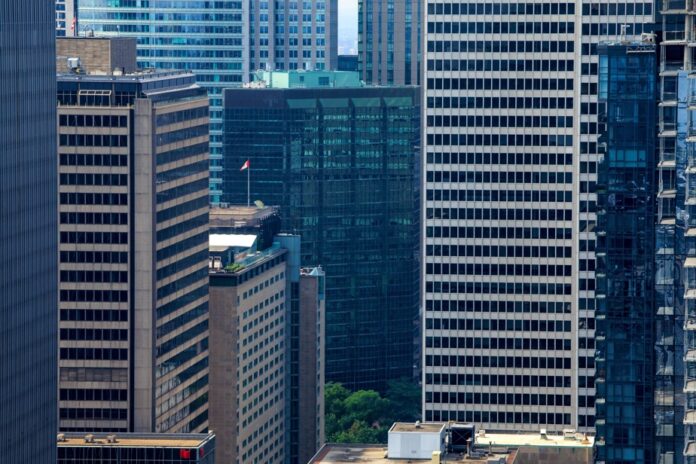Place Bonaventure (800, rue De La Gauchetière), the Bell Tower of the Bell National Bank Complex (now called 1001, Robert-Bourassa), the Stock Exchange Tower (800, rue du Square-Victoria), 1100, René-Lévesque, 111 Robert-Bourassa, in the Cité du Multimédia, and the head office of SNC-Lavalin (Place Félix-Martin at 455, boulevard René-Lévesque) are among the downtown towers with the most offices available, according to a review prepared by a real estate agency at the request of La Presse dated July 19.
The available area varies from 20,000 to 35,000 square meters (m2), the equivalent of 1250 workstations in each of these towers. Data may have since changed.
An available office is an office ready to quickly accommodate a tenant, whether or not its owner receives rent for the office in question. Often, the availability rate adds up the vacant offices and the offices offered for sublet.
The office availability rate varies between 28% for Place Bonaventure and 57% for Place Félix-Martin.
However, the situation specific to each building can change rapidly. “We recently concluded a transaction at the Tour de la Bourse for 100,000 square feet [9300 m2], which brings us back to the current average vacancy rates,” said Vincent Chiara, founding president of Groupe Mach, who holds interests in the building. As for 1100, René-Lévesque, he maintains that the vacancy rate (and not availability) fluctuates between 15% and 16%, which is not alarming in the context.
“You put in your figures the area of our former showroom of nearly 300,000 sq. Hylands, president of Kevric, responsible for running this downtown juggernaut. “It’s not the Klondike, the current market, but it’s not a black tunnel,” he sums up.
The other owners concerned by our compilation, Allied and GWL, did not respond to our request for maintenance.
Allied’s publicly traded real estate investment trust (REIT) released its most recent quarterly report as of June 30, in which the numbers match ours for 111 and 1001 Robert-Bourassa.
The marked increase in office availability is not without consequences.
In New York, there are fears of a spiral where high vacancy translates into a decline in building value, which leads to lower municipal taxes, causing a loss of revenue for the City. .
More employees are working from home.
The leases in the towers are not renewed or are renewed with a reduced area.
The value of office buildings is eroding.
Revenues from property taxes are declining, which has an impact on the City’s budget.
The City is obliged to increase its tax rate or impose new fees.
The increased tax burden is detrimental to the City’s attractiveness to talent and businesses.
Columbia Business School real estate professor Stijn Van Nieuwerburgh, quoted in The New York Times, says his research predicts a 45% decline in the value of Manhattan skyscrapers by 2029.
So far, values have held up in downtown Montreal, experts say, but for how long?
The hour of truth will come when the owners renew their financing, believes a veteran of the real estate scene. “When a mortgage comes due, the owner sits down with his creditor,” explains Jean Laurin, partner and president for Quebec of the agency Avison Young. The owner will ask him if he can restructure the loan or extend the term. For his part, the banker will ask him if he can give some money. This is the kind of discussion we have in life when things are going badly. »
The professionals we spoke to were reassuring. The banking system, more regulated in Canada, is not the same as in the United States, explain MM. Hylands and Chiara. In our neighbors to the south, the loans are usually without recourse other than the building under mortgage. It is common for landlords to hand over the keys to the creditor when conditions deteriorate.
In Montreal, what we are witnessing at the moment is the move upmarket of tenants.
Office users take advantage of the end of their lease to reduce the surface area by 15 to 20% and move to a newer building.
“It’s not catastrophic, wants to reassure Vincent Chiara. The effective net rent [which remains in the pockets of the lessor once the concessions granted to the tenants have been subtracted] is down slightly. It is between $12 and $15 per square foot, according to the real estate mogul, who owns interests in 1000, De La Gauchetière, 1155, René-Lévesque Ouest and the Sun Life Building. We are not in the Calgary market where transactions are made with an effective net rent of $0. »
Still, with rising interest rates, rising vacancies and flat or falling rents, it seems inevitable that the value of office buildings will take a hit sooner or later.
“The most modern offices, like 1000, De La Gauchetière, perform very well. Base rental rates are even up slightly. On the other hand, the older buildings, categories B and C, will suffer,” says Brent Robinson, managing director of the Cushman agency.
“In Canada, the offices are owned by big institutions,” counters Richard Hylands, whose company Kevric teams up with the manager of the federal public service pension fund, PSP Investments. They have the means to be patient. “We haven’t seen any fire sales. Homeowners are waiting for the storm to pass and interest rates to come back down,” he said.















